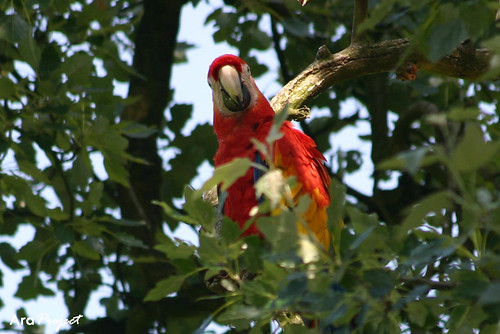Gnats killing birds in area
 Wednesday, April 21, 2010 at 8:00
Wednesday, April 21, 2010 at 8:00  A Scarlet MacawA mysterious rash of bird deaths in the Teche Area has left residents wondering its cause.
A Scarlet MacawA mysterious rash of bird deaths in the Teche Area has left residents wondering its cause.
New Iberia resident Sandy Sawyer said a coworker at the Humane Society on Troy Road began telling her about the bird deaths early last week.
“My friend said that all her chickens and quails were dying,” Sawyer said. “She said there was blood and sores all under the feathers from bugs that looked like some kind of large black gnat.”
Sawyer said later that week she made the horrifying discovery of her scarlet macaw, Harley, laying motionless on her patio.
She said she brushed through the parrot’s feathers and found hundreds of insects feeding off the bird’s skin. Some of the winged insects, she said, were so full of blood they burst when she touched them.
Sawyer’s bird survived the ordeal, but she said it was weak for two days.
Director of Iberia Parish Mosquito Control Herff Jones said he has never heard of such an insect that could cause fowl and other outdoor birds to die overnight.
“I’m not aware of such an insect,” Jones said. “But I am aware that during this time of year weather patterns cause breeding of certain biting species.”
He said the most common is a subspecies of gnat formally called Culicoides that is indigenous to Iberia Parish and surrounding areas. He said the gnats are too small to be killed by insecticide, but using products such as Sevin Dust on outdoor fowl can protect them from getting bitten.
“It’s a seasonal thing,” Jones said. “They cause a nuisance to mostly humans. They will bite and take very small portions of blood, extremely small. They tend to irritate around the face and ears. They move around in breeding swarms all day and are pretty persistent.”
Dr. Lane Foil, a professor of veterinary insects for Louisiana State University’s Etomology Department, cited a species found in the Merck Veterinary Manual as a possible culprit in the bird deaths.
He suggested the insects are a form of fly in the Simulidae family, commonly known as “black flies” or “buffalo gnats.”
According to the Merck Veterinary Manual, black flies feed “on all classes of livestock, wildlife, birds and humans.” The manual went on to say that the female insects cause the most painful bites, and breed in water.
“The ears, neck, head and abdomen of cattle are favorite feeding sites,” the manual explained. “In addition to local reactions (redness, itching, wheals) at the bite site, there may be general conditions that vary in intensity with the sensitivity of the animal and the number of bites. Attacks by large numbers of black flies can cause severe damage and high mortality in livestock. Humans may be similarly attacked.”
Andy Kilchrist of New Iberia said she has talked to residents from Avery Island, St. Martinville, Loreauville and Jefferson Island who have had birds die since the beginning of last week. Two of her chickens also died overnight last week, she said.
“I’m familiar with stinging and biting gnats” Kilchrist said. “But this year I’ve never seen where the gnats get so bad under the feathers of these birds.”
Sawyer said she brings her geese and chickens indoors during the evening to keep them safe. She said the rash of avian deaths is not something the parish is familiar with.
“I’ve been talking to everyone till I’m blue in the face and nobody remembers gnats sucking blood before,” Sawyer said.
 Ara macao - Scarlet Macaw | in
Ara macao - Scarlet Macaw | in  Disease
Disease 
